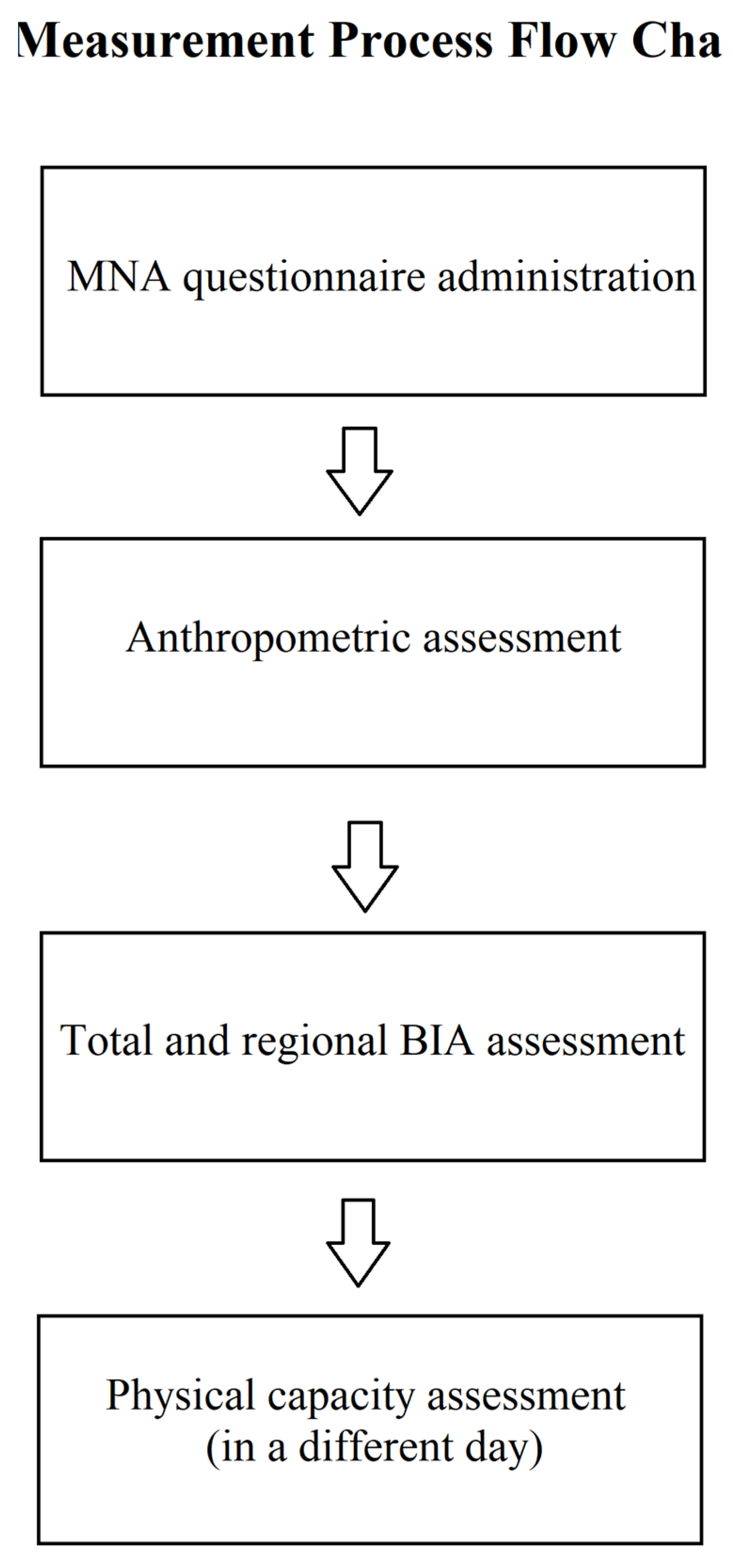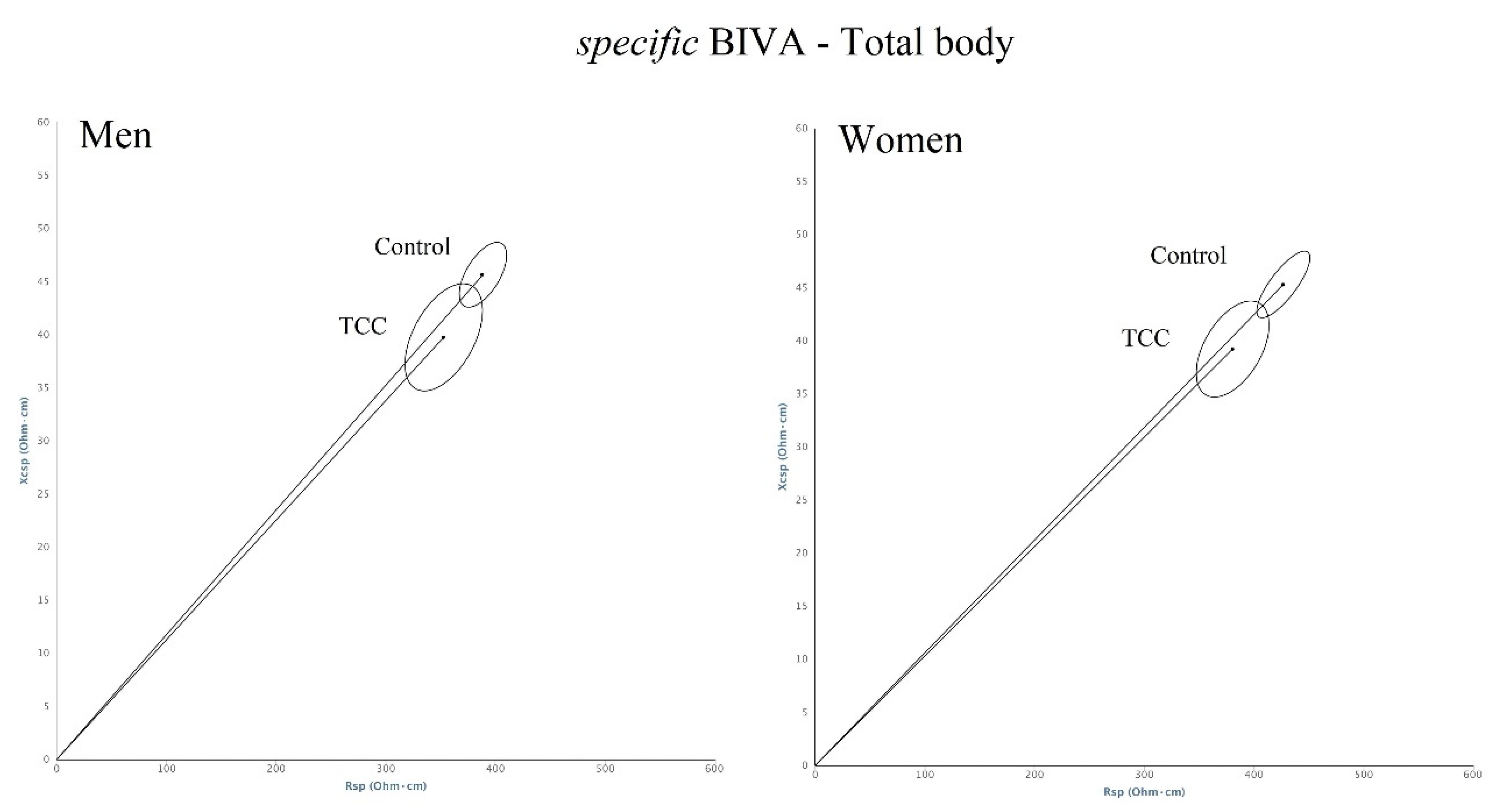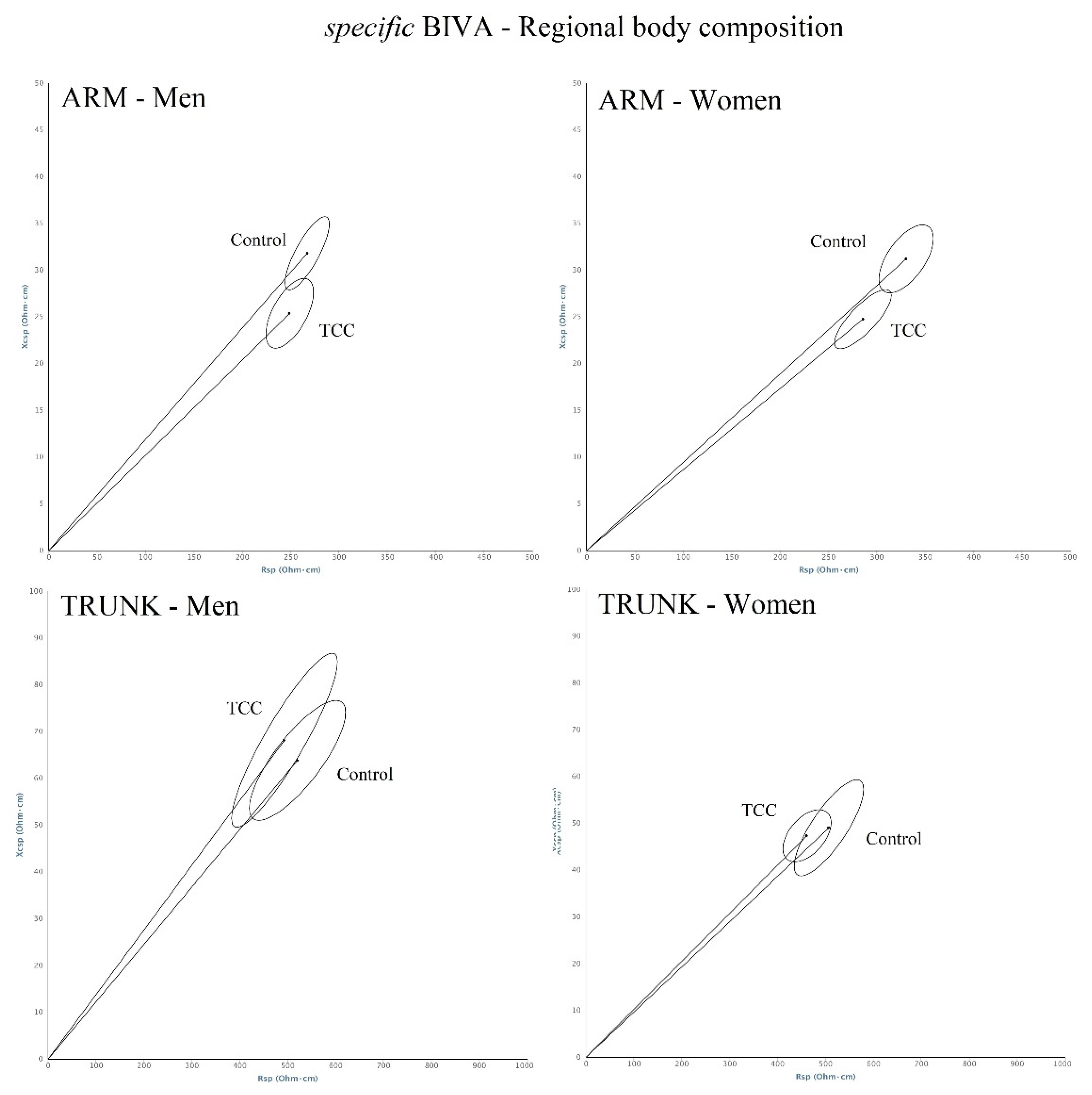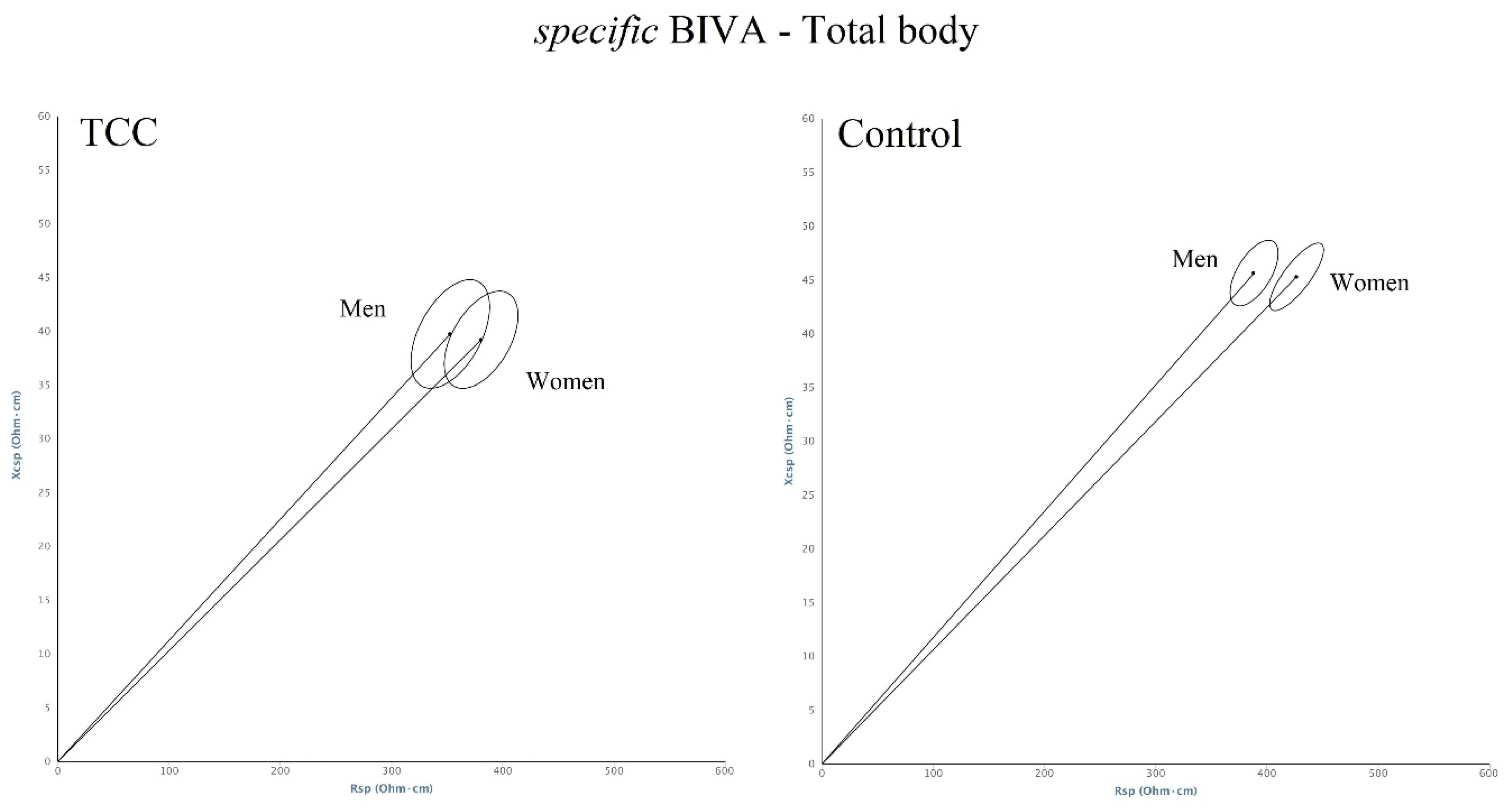Lower Percentage of Fat Mass among Tai Chi Chuan Practitioners
Abstract
1. Introduction
2. Materials and Methods
2.1. Subjects
2.2. Measurements
2.2.1. Anthropometry
2.2.2. Bioimpedance
2.2.3. Hand-Grip Strength
2.2.4. Mini-Nutritional Assessment
2.2.5. Physical Capacity Assessment
2.3. Statistical Analysis
3. Results
4. Discussions
5. Conclusions
Author Contributions
Funding
Acknowledgments
Conflicts of Interest
References
- Buffa, R.; Floris, G.U.; Putzu, P.F.; Marini, E. Body composition variations in ageing. Coll. Antropol. Zabreg 2011, 35, 259–265. [Google Scholar]
- Cruz-Jentoft, A.J.; Bahat, G.; Bauer, J.; Boirie, Y.; Bruyère, O.; Cederholm, T.; Cooper, C.; Landi, F.; Rolland, Y.; Sayer, A.A.; et al. Sarcopenia: Revised European consensus on definition and diagnosis. Age Ageing 2019, 48, 16–31. [Google Scholar] [CrossRef]
- Koolhaas, C.M.; Dhana, K.; Van Rooij, F.J.A.; Schoufour, J.; Hofman, A.; Franco, O.H. Physical activity type and health-related quality of life among middle-aged and elderly adults: The Rotterdam study. J. Nutr. Health Aging 2018, 22, 246–253. [Google Scholar] [CrossRef]
- Kelly, O.J.; Gilman, J.C. Can unconventional exercise be helpful in the treatment, management and prevention of osteosarcopenic obesity? Curr. Aging Sci. 2017, 10, 106–121. [Google Scholar] [CrossRef]
- Fien, S.; Climstein, M.; Quilter, C.; Buckley, G.; Henwood, T.; Grigg, J.; Keogh, J.W.L. Anthropometric, physical function and general health markers of masters athletes: A cross-sectional study. Peer J. 2017, 5, e3768. [Google Scholar] [CrossRef] [PubMed]
- Hinton, B.J.; Fan, B.; Ng, B.K.; Shepherd, J.A. Dual energy X-Ray Absorptiometry body composition reference values of limbs and trunk from NHANES 1999-2004 with additional visualization methods. PLoS ONE 2017, 12, 1–17. [Google Scholar] [CrossRef] [PubMed]
- Wong, A.M.K.; Pei, Y.C.; Lan, C.; Huang, S.C.; Lin, Y.C.; Chou, S.W. Is Tai Chi Chuan Effective in Improving Lower Limb Response Time to Prevent Backward Falls in the Elderly? Age 2009, 31, 163–170. [Google Scholar] [CrossRef] [PubMed]
- Qin, L.; Choy, W.; Leung, K.; Leung, P.C.; Au, S.; Hung, W.; Dambacher, M.; Chan, K. Beneficial Effects of Regular Tai Chi Exercise on Musculoskeletal System. J. Bone Miner. Metab. 2005, 23, 186–190. [Google Scholar] [CrossRef]
- Lan, C.; Lai, J.S.; Wong, M.K.; Yu, M.L. Cardiorespiratory Function, Flexibility, and Body Composition among Geriatric Tai Chi Chuan Practitioners. Arch. Phys. Med. Rehabil. 1996, 77, 612–616. [Google Scholar] [CrossRef]
- Chan, A.W.K.; Yu, D.S.F.; Choi, K.C. Effects of Tai Chi Qigong on Psychosocial Well-Being Among Hidden Elderly, Using Elderly Neighborhood Volunteer Approach: A Pilot Randomized Controlled Trial. Clin. Interv. Aging 2017, 12, 85–96. [Google Scholar] [CrossRef]
- Lim, K.H.L.; Pysklywec, A.; Plante, M.; Demers, L. The Effectiveness of Tai Chi for Short-Term Cognitive Function Improvement in the Early Stages of Dementia in the Elderly: A Systematic Literature Review. Clin. Interv. Aging 2019, 14, 827–839. [Google Scholar] [CrossRef] [PubMed]
- Yu, T.-Y.; Pei, Y.-C.; Lau, Y.-C.; Chen, C.-K.; Hsu, H.-C.; Wong, A.M.K. Comparison of the Effects of Swimming and Tai Chi Chuan on Body Fat Composition in Elderly People. Chang Gung Med. J. 2007, 30, 128–134. [Google Scholar] [PubMed]
- Barbat-Artigas, S.; Filion, M.E.; Dupontgand, S.; Karelis, A.D.; Aubertin-Leheudre, M. Effects of Tai Chi Training in Dynapenic and Nondynapenic Postmenopausal Women. Menopause 2011, 18, 974–979. [Google Scholar] [CrossRef] [PubMed]
- Hsu, W.H.; Hsu, R.W.W.; Lin, Z.R.; Fan, C.H. Effects of Circuit Exercise and Tai Chi on Body Composition in Middle-Aged and Older Women. Geriatr. Gerontol. Int. 2015, 15, 282–288. [Google Scholar] [CrossRef] [PubMed]
- Hui, S.S.; Xie, Y.J.; Woo, J.; Kwok, T.C.Y. Practicing Tai Chi had lower energy metabolism than walking but similar health benefits in terms of aerobic fitness, resting energy expenditure, body composition and self-perceived physical health. Complement. Ther. Med. 2016, 27, 43–50. [Google Scholar] [CrossRef] [PubMed]
- Lai, H.M.; Liu, M.S.Y.; Lin, T.J.; Tsai, Y.L.; Chien, E.J. Higher Dheas Levels Associated with Long-Term Practicing of Tai Chi. Chin. J. Physiol. 2017, 60, 124–130. [Google Scholar] [CrossRef]
- Dechamps, A.; Gatta, B.; Bourdel-Marchasson, I.; Tabarin, A.; Roger, P. Pilot Study of a 10-Week Multidisciplinary Tai Chi Intervention in Sedentary Obese Women. Clin. J. Sport Med. 2009, 19, 49–53. [Google Scholar] [CrossRef]
- Buffa, R.; Mereu, E.; Comandini, O.; Ibanez, M.E.; Marini, E. Bioelectrical Impedance Vector Analysis (BIVA) for the Assessment of Two-Compartment Body Composition. Eur. J. Clin. Nutr. 2014, 68, 1234. [Google Scholar] [CrossRef]
- Buffa, R.; Saragat, B.; Cabras, S.; Rinaldi, A.C.; Marini, E. Accuracy of Specific BIVA for the Assessment of Body Composition in the United States Population. PLoS ONE 2013, 8, e58533. [Google Scholar] [CrossRef]
- Marini, E.; Sergi, G.; Succa, V.; Saragat, B.; Sarti, S.; Coin, A.; Manzato, E.; Buffa, R. Efficacy of Specific Bioelectrical Impedance Vector Analysis (BIVA) for Assessing Body Composition in the Elderly. J. Nutr. Health Aging 2013, 17, 515–521. [Google Scholar] [CrossRef]
- Saragat, B.; Buffa, R.; Mereu, E.; De Rui, M.; Coin, A.; Sergi, G.; Marini, E. Specific bioelectrical impedance vector reference values for assessing body composition in the Italian elderly. Exp. Gerontol. 2014, 50, 52–56. [Google Scholar] [CrossRef] [PubMed]
- Marini, E.; Campa, F.; Buffa, R.; Stagi, S.; Matias, C.N.; Toselli, S.; Sardinha, L.B.; Silva, A.M. Phase Angle and Bioelectrical Impedance Vector Analysis in the Evaluation of Body Composition in Athletes. Clin. Nutr. 2019. [Google Scholar] [CrossRef] [PubMed]
- Norman, K.; Stobäus, N.; Pirlich, M.; Bosy-Westphal, A. Bioelectrical phase angle and impedance vector analysis–clinical relevance and applicability of impedance parameters. Clin. Nutr. 2012, 31, 854–861. [Google Scholar] [CrossRef] [PubMed]
- Campa, F.; Matias, C.N.; Marini, E.; Heymsfield, S.B.; Toselli, S.; Sardinha, L.B.; Silva, A.M. Identifying athlete body-fluid changes during a competitive season with bioelectrical impedance vector analysis. Int. J. Sports Physiol. Perform. 2019, 1, 1–21. [Google Scholar] [CrossRef]
- Castizo-Olier, J.; Irurtia, A.; Jemni, M.; Carrasco-Marginet, M.; Fernández-García, R.; Rodríguez, F.A. Bioelectrical Impedance Vector Analysis (BIVA) in Sport and Exercise: Systematic Review and Future Perspectives. PLoS ONE 2018, 13, e0197957. [Google Scholar] [CrossRef]
- Antoni, G.; Marini, E.; Curreli, N.; Tuveri, V.; Comandini, O.; Cabras, S.; Gabba, S.; Madeddu, C.; Crisafulli, A.; Rinaldi, A.C. Energy expenditure in caving. PLoS ONE 2017, 12, e0170853. [Google Scholar] [CrossRef]
- Toselli, S.; Marini, E.; Maietta Latessa, P.; Benedetti, L.; Campa, F. Maturity Related Differences in Body Composition Assessed by Classic and Specific Bioimpedance Vector Analysis among Male Elite Youth Soccer Players. Int. J. Environ. Res. Public Health 2020, 22, 729. [Google Scholar] [CrossRef]
- Lohman, T.G.; Roche, A.F.; Martorell, R. Anthropometric Standardization Reference Manual; Human Kinetics Books Champaign: Champaign, IL, USA, 1988. [Google Scholar]
- World Health Organization. Obesity: Preventing and Managing the Global Epidemic. Report of a WHO Consultation; World Health Organization Technical Report Series; WHO: Geneva, Switzerland, 2000; Volume 894, pp. 1–253. [Google Scholar]
- Kyle, U.G.; Bosaeus, I.; De Lorenzo, A.D.; Deurenberg, P.; Elia, M.; Manuel Gómez, J.; Lilienthal Heitmann, B.; Kent-Smith, L.; Melchior, J.C.; Pirlich, M.; et al. Bioelectrical impedance analysis—Part II: Utilization in clinical practice. Clin. Nutr. 2004, 23, 1430–1453. [Google Scholar] [CrossRef]
- Baumgartner, R.N.; Chumlea, W.C.; Roche, A.F. Bioelectric Impedance Phase Angle and Body Composition. Am. J. Clin. Nutr. 1988, 48, 16–23. [Google Scholar] [CrossRef]
- Fuller, N.J.; Elia, M. Potential Use of Bioelectrical Impedance of the “whole Body” and of Body Segments for the Assessment of Body Composition: Comparison with Densitometry and Anthropometry. Eur. J. Clin. Nutr. 1989, 43, 779–791. [Google Scholar]
- Dodds, R.M.; Syddall, H.E.; Cooper, R.; Benzeval, M.; Deary, I.J.; Dennison, E.M.; Der, G.; Gale, C.R.; Inskip, H.M.; Jagger, C.; et al. Grip Strength across the Life Course: Normative Data from Twelve British Studies. PLoS ONE 2014, 9, e113637. [Google Scholar] [CrossRef] [PubMed]
- Guigoz, Y. The Mini Nutritional Assessment (MNA®) Review of the Literature-What Does It Tell Us? J. Nutr. Health Aging 2006, 10, 466. [Google Scholar]
- Crisafulli, A.; Piras, F.; Chiappori, P.; Votelli, S.; Caria, M.A.; Lobina, A.; Millia, R.; Tocco, F.; Concu, A.; Melis, F. Estimating stroke volume from oxygen pulse during exercise. Physiol. Meas. 2007, 28, 1201. [Google Scholar] [CrossRef] [PubMed]
- Howley, E.T.; Bassett, D.R.; Welch, H. Criteria for maximal oxygen uptake: Review and commentary. Med. Sci. Sports Exerc. 1995, 27, 1292–1301. [Google Scholar] [CrossRef]
- Cohen, J. Statistical Power Analysis for the Behavioral Sciences; Routledge: London, UK, 2013. [Google Scholar]
- Neeland, I.J.; Ross, R.; Després, J.P.; Matsuzawa, Y.; Yamashita, S.; Shai, I.; Seidell, J.; Magni, P.; Santos, R.D.; Arsenault, B.; et al. Visceral and ectopic fat, atherosclerosis, and cardiometabolic disease: A position statement. Lancet Diabetes Endocrinol. 2019, 7, 715–725. [Google Scholar] [CrossRef]
- Bosy-Westphal, A.; Booke, C.A.; Blöcker, T.; Kossel, E.; Goele, K.; Later, W.; Heller, M.; Glüer, C.C.; Müller, M.J. Measurement site for waist circumference affects its accuracy as an index of visceral and abdominal subcutaneous fat in a Caucasian population. J. Nutr. 2010, 140, 954–996. [Google Scholar] [CrossRef]
- Manor, B.; Lough, M.; Gagnon, M.M.; Cupples, A.; Wayne, P.M.; Lipsitz, L.A. Functional benefits of tai chi training in senior housing facilities. J. Am. Geriatr. Soc. 2014, 62, 1484–1489. [Google Scholar] [CrossRef]
- Lan, C.; Lai, J.S.; Chen, S.Y.; Wong, M.K. 12-month Tai Chi training in the elderly: Its effect on health fitness. Med. Sci. Sports Exerc. 1998, 30, 345–351. [Google Scholar] [CrossRef]
- Buffa, R.; Marini, E.; Floris, G. Variation in sexual dimorphism in relation to physical activity. Am. J. Hum. Biol. 2001, 13, 341–348. [Google Scholar] [CrossRef]




| Total Body Composition | Tai Chi Chuan | Control | F | ||||||||
|---|---|---|---|---|---|---|---|---|---|---|---|
| Men (n = 14) | Women (n = 20) | Men (n = 49) | Women (n = 56) | ||||||||
| Mean | s.d. | Mean | s.d. | Mean | s.d. | Mean | s.d. | psex | psport | psex•sport | |
| Age (y) | 63.4 | 7.9 | 62.5 | 7.1 | 62.9 | 6.6 | 62.8 | 6.4 | 0.713 | 0.948 | 0.763 |
| Height (cm) | 172.2 | 5.1 | 155.5 | 6.7 | 166.1 | 6.2 | 153.2 | 6.7 | 0.000 | 0.001 | 0.151 |
| Weight (kg) | 70.1 | 7.2 | 54.1 | 7.4 | 77.8 | 11.8 | 64.0 | 11.5 | 0.000 | 0.000 | 0.615 |
| BMI (kg/m2) | 23.7 | 2.5 | 22.4 | 3.0 | 28.2 | 4.1 | 27.3 | 4.7 | 0.186 | 0.000 | 0.824 |
| Waist (cm) | 87.2 | 9.0 | 74.0 | 6.9 | 97.4 | 11.3 | 85.2 | 12.1 | 0.000 | 0.000 | 0.822 |
| Arm (cm) | 28.6 | 2.1 | 26.0 | 2.2 | 30.3 | 3.1 | 29.0 | 3.2 | 0.000 | 0.000 | 0.297 |
| Calf (cm) | 35.2 | 2.0 | 33.0 | 2.4 | 36.8 | 3.3 | 34.9 | 3.7 | 0.002 | 0.009 | 0.876 |
| Rsp (ohm·cm) | 352.7 | 45.6 | 380.4 | 54.2 | 454.9 | 56.3 | 553.2 | 50.5 | 0.010 | 0.001 | 0.677 |
| Xcsp (ohm·cm) | 39.7 | 6.5 | 39.2 | 7.4 | 53.4 | 8.9 | 58.8 | 9.1 | 0.794 | 0.001 | 0.955 |
| Zsp (ohm·cm) | 355.0 | 45.6 | 382.5 | 54.3 | 391.12 | 59.4 | 429.0 | 71.8 | 0.011 | 0.001 | 0.680 |
| Phase angle sp (°) | 6.5 | 1.0 | 5.9 | 1.0 | 6.7 | 1.0 | 6.1 | 0.8 | 0.001 | 0.275 | 0.756 |
| Regional Body Composition | Men (n = 14) | Women (n = 20) | Men (n = 27) | Women (n = 33) | psex | psport | psex•sport | ||||
| Arm: R sp (ohm·cm) | 248.8 | 31.7 | 285.4 | 47.9 | 266.9 | 44.7 | 330.0 | 61.9 | 0.000 | 0.005 | 0.230 |
| Arm: Xc sp (ohm·cm) | 25.4 | 4.8 | 24.7 | 5.2 | 31.8 | 7.65 | 31.2 | 8.0 | 0.687 | 0.000 | 0.993 |
| Arm: Z sp sp (ohm·cm) | 250.1 | 31.8 | 286.4 | 48.1 | 268.8 | 45.03 | 331.6 | 62.0 | 0.000 | 0.005 | 0.235 |
| Arm: phase angle sp (°) | 5.8 | 1.0 | 5.0 | 0.6 | 6.8 | 1.1 | 5.4 | 1.1 | 0.000 | 0.002 | 0.287 |
| Leg: R sp (ohm·cm) | 254.6 | 17.4 | 287.0 | 34.2 | 255.2 | 44.4 | 297.9 | 58.52 | 0.000 | 0.562 | 0.601 |
| Leg: Xc sp (ohm·cm) | 27.3 | 3.6 | 29.6 | 8.0 | 31.3 | 9.6 | 31.7 | 9.9 | 0.476 | 0.116 | 0.621 |
| Leg: Z sp sp (ohm·cm) | 256.1 | 17.4 | 288.7 | 33.7 | 257.2 | 45.0 | 299.7 | 58.9 | 0.000 | 0.545 | 0.619 |
| Leg: phase angle sp (°) | 6.1 | 0.8 | 6.0 | 2.2 | 6.9 | 1.4 | 6.03 | 1.3 | 0.135 | 0.229 | 0.241 |
| Trunk: R sp (ohm·cm) | 492.9 | 142.5 | 436.5 | 132.4 | 520.0 | 196.8 | 506.7 | 159.3 | 0.523 | 0.305 | 0.791 |
| Trunk: Xc sp (ohm·cm) | 68.1 | 24.1 | 44.8 | 14.0 | 63.8 | 25.1 | 49.0 | 22.6 | 0.000 | 0.793 | 0.538 |
| Trunk: Z sp sp (ohm·cm) | 497.7 | 144.1 | 438.9 | 132.9 | 524.0 | 198.0 | 509.2 | 160.4 | 0.491 | 0.313 | 0.783 |
| Trunk: phase angle sp (°) | 7.8 | 1.4 | 5.9 | 1.0 | 7.1 | 1.4 | 5.4 | 1.4 | 0.000 | 0.048 | 0.700 |
| Hand grip (kg) | 39.6 | 8.9 | 24.3 | 5.0 | 38.0 | 9.4 | 23.6 | 5.4 | 0.000 | 0.789 | 0.913 |
| Average Result for the Whole Group | ||||||||
| Workload (w) | V̇O2 (mL/kg·min−1) | V̇O2 (mL·min−1) | V̇CO2 (mL·min−1) | RER | VE (L·min−1) | HR (bpm) | OP (mL·bpm−1) | |
| Rest | 0 | 4.05 ± 0.79 | 257.5 ± 57.5 | 249.1 ± 73.5 | 0.96 ± 0.16 | 9.1 ± 2.8 | 77.6 ± 13.7 | 3.4 ± 1.1 |
| WAT | 90.7 ± 40.0 | 18.03 ± 5.41 | 1153.4 ± 409.8 | 1303.6 ± 522.6 | 1.12 ± 0.13 | 35.8 ± 12.4 | 130.9 ± 24.2 | 8.8 ± 2.5 |
| Wmax | 119.4 ± 49.4 | 22.76 ± 6.63 | 1449.3 ± 473.3 | 1824.3 ± 669.5 | 1.25 ± 0.13 | 54.9 ± 18.9 | 150.3 ± 25.6 | 9.7 ± 2.8 |
| Average Results for Women Subgroup | ||||||||
| Rest | 0 | 4.08 ± 0.90 | 233.5 ± 52.7 | 228.9 ± 86.7 | 0.96 ± 0.21 | 8.2 ± 2.9 | 80.0 ± 12.5 | 2.9 ± 0.8 |
| WAT | 73.1 ± 30.8 | 18.91 ± 4.09 | 976.12 ± 267.3 | 1075.1 ± 286.9 | 1.11 ± 0.16 | 29.4 ± 7.9 | 131.1 ± 19.7 | 7.4 ± 1.5 |
| Wmax | 92.7 ± 32.5 | 19.75 ± 3.90 | 1142.8 ± 278.6 | 1429.3 ± 361.3 | 1.25 ± 0.42 | 43.0 ± 12.4 | 148.3 ± 18.2 | 7.7 ± 1.6 |
| Average Results for Men Subgroup | ||||||||
| Rest | 0 | 4.14 ± 0.84 | 291.0 ± 52.4 | 287.4 ± 47.2 | 0.99 ± 0.11 | 10.7 ± 2.1 | 73.5 ± 15.0 | 4.1 ± 1.1 |
| WAT | 95.4 ± 33.7 | 16.99 ± 4.79 | 1194.2 ± 311.5 | 1375.9 ± 435.4 | 1.14 ± 0.11 | 39.3 ± 11.8 | 122.0 ± 27.1 | 9.8 ± 2.1 |
| Wmax | 128.6 ± 44.8 | 22.81 ± 6.09 | 1583.6 ± 309.0 | 1995.4 ± 566.9 | 1.24 ± 0.15 | 61.5 ± 18.7 | 140.7 ± 28.0 | 11.4 ± 1.7 |
© 2020 by the authors. Licensee MDPI, Basel, Switzerland. This article is an open access article distributed under the terms and conditions of the Creative Commons Attribution (CC BY) license (http://creativecommons.org/licenses/by/4.0/).
Share and Cite
Stagi, S.; Doneddu, A.; Mulliri, G.; Ghiani, G.; Succa, V.; Crisafulli, A.; Marini, E. Lower Percentage of Fat Mass among Tai Chi Chuan Practitioners. Int. J. Environ. Res. Public Health 2020, 17, 1232. https://doi.org/10.3390/ijerph17041232
Stagi S, Doneddu A, Mulliri G, Ghiani G, Succa V, Crisafulli A, Marini E. Lower Percentage of Fat Mass among Tai Chi Chuan Practitioners. International Journal of Environmental Research and Public Health. 2020; 17(4):1232. https://doi.org/10.3390/ijerph17041232
Chicago/Turabian StyleStagi, Silvia, Azzurra Doneddu, Gabriele Mulliri, Giovanna Ghiani, Valeria Succa, Antonio Crisafulli, and Elisabetta Marini. 2020. "Lower Percentage of Fat Mass among Tai Chi Chuan Practitioners" International Journal of Environmental Research and Public Health 17, no. 4: 1232. https://doi.org/10.3390/ijerph17041232
APA StyleStagi, S., Doneddu, A., Mulliri, G., Ghiani, G., Succa, V., Crisafulli, A., & Marini, E. (2020). Lower Percentage of Fat Mass among Tai Chi Chuan Practitioners. International Journal of Environmental Research and Public Health, 17(4), 1232. https://doi.org/10.3390/ijerph17041232






